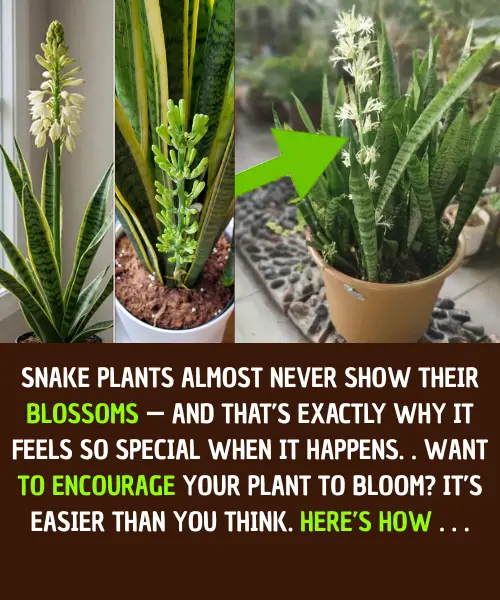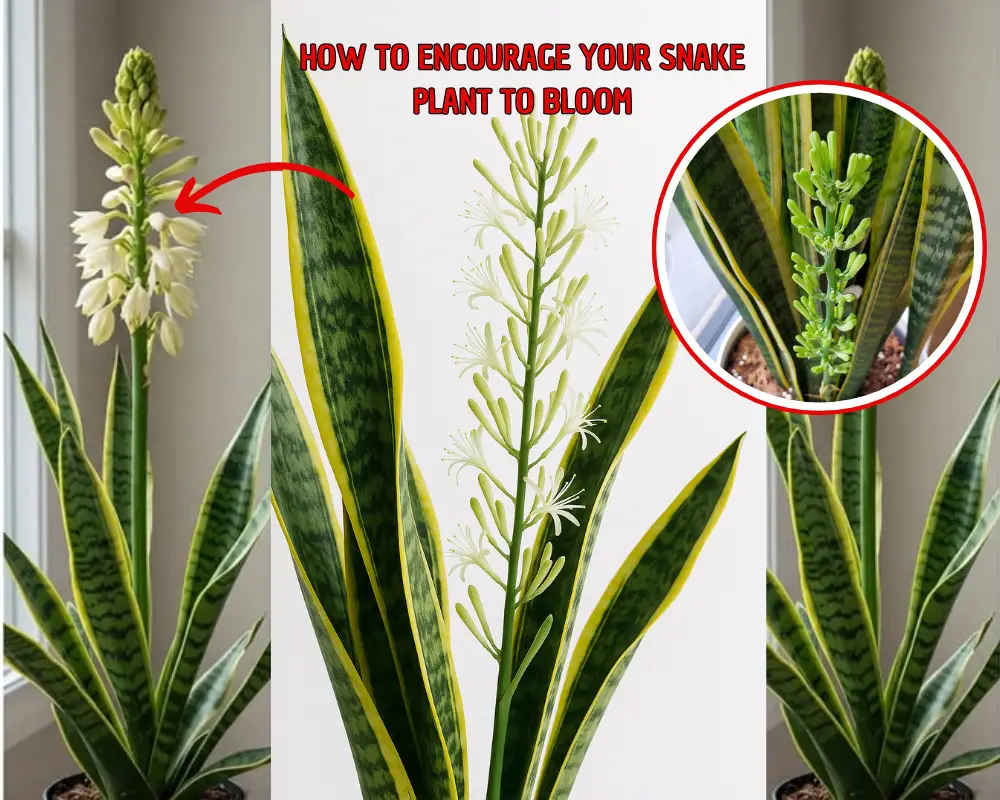Snake Plant Blossoms: Why They’re Rare and How to Encourage Your Snake Plant to Bloom
Snake Plant Blossoms
The snake plant (Sansevieria / Dracaena trifasciata) is one of the most admired houseplants in the world. Its upright, sword-shaped leaves, minimal care requirements, and ability to thrive in almost any environment make it a favorite for beginners and collectors alike. What many people never realize, however, is that snake plants are capable of producing beautiful, fragrant blossoms — long, elegant flower spikes covered in delicate white or pale green blooms.
Seeing a snake plant in bloom is an uncommon and meaningful experience. For many plant lovers, it feels like a quiet celebration — a sign that the plant is not just surviving, but truly thriving.
Yet most snake plants never bloom indoors.
This guide explains everything you need to know about snake plant flowers: what they look like, why they are rare, what signals the plant to produce them, and most importantly, how you can encourage your snake plant to blossom at home.
What Makes Snake Plant Blossoms So Special?
Most houseplants with dramatic flowers require consistent humidity, specialized lighting, or careful feeding schedules. The snake plant is different. It doesn’t bloom frequently, and when it does, it’s usually a result of long-term stability and subtle environmental signals.
The blossoms typically:
- Grow on a tall, thin flower stalk (up to 2–3 feet tall)
- Appear as clusters of slender, narrow petals
- Range from creamy white to soft green
- Release a sweet fragrance, especially at night
- Produce small drops of nectar on the petals or stalk
The scent can be described as:
- Light and sweet, similar to jasmine or vanilla
- Stronger in the evening
- Soft enough to be pleasant rather than overwhelming
Because this flowering event is so uncommon, plant owners often feel surprised, proud, or deeply connected to their plant when it happens.
Why Snake Plant Blossoms Are Rare Indoors
To understand how to encourage blooming, it helps to know why blooming doesn’t happen often inside homes.
In nature, snake plants experience:
- Bright, filtered sunlight for many hours per day
- Heat and warm nights
- Long periods of dry soil followed by heavy rain
- Crowded growing conditions, where roots press tightly into the soil
Indoors, on the other hand:
- Light levels are often lower than we think
- Watering may be too frequent
- Temperature fluctuates more due to heating/cooling systems
- The plant may be repotted too soon, removing the “crowded root” trigger
Snake plants need to reach a mature, comfortable state before they flower. They must have:
- Energy stored in their leaves
- A strong, developed root system
- A consistent environment with minimal disruption
Once those conditions are met, the plant may redirect energy from leaf production to flower production, resulting in blooms.
How to Encourage a Snake Plant to Bloom

Below are the key conditions that support flowering. These are based on both botanical behavior and real grower experience.
1. Give the Plant Bright, Indirect Light (This Is the Most Important Factor)
Snake plants tolerate low light, but they do not bloom in low light.
To encourage flowering:
- Place your snake plant near a bright window
- Ideal windows: South, East, or West-facing
- Allow several hours of filtered daylight each day
If your plant has been living in dim light, gradually increase brightness over 2–3 weeks to avoid leaf shock.
2. Let the Soil Dry Completely Between Waterings
Snake plants store water in their leaves and roots. If the soil stays moist too often, the plant remains in “survival mode” and will not produce flowers.
Watering rules:
- Check the soil all the way down — it must be fully dry before watering
- In summer: water every 2–4 weeks
- In winter: water every 4–8 weeks (sometimes even less)
Overwatering is the number one cause of root rot and no flowering.
3. Use a Fast-Draining Soil Mix
The right soil allows oxygen around the roots and prevents moisture buildup.
Recommended mix:
- 2 parts cactus or succulent soil
- 1 part perlite or pumice
- Optional: 1 part orchid bark for even better drainage
Never use dense potting soil alone.
4. Let the Plant Become Slightly Root-Bound
This is one of the biggest secrets to getting blooms.
Snake plants bloom more frequently when:
- Roots fill the pot
- New shoots are growing tightly around each other
- The plant feels “crowded”
Do not repot just because roots are visible at the top of the soil or holes. That is often a good sign.
Repot only when:
- The pot is cracking
- Growth has stopped completely
5. Provide Warm Temperatures and Consistency
Snake plants thrive in:
- Daytime: 70–85°F (21–29°C)
- Night: 65–75°F (18–24°C)
Avoid:
- Air conditioners blowing directly on the plant
- Drafty windows in winter
- Moving the plant frequently
Once the plant starts forming a flower spike, do not rotate or relocate it.
6. Fertilize Sparingly, But Correctly
Snake plants do not need heavy feeding.
Best approach:
- Use a balanced liquid fertilizer (e.g., 10-10-10)
- Dilute to ¼ strength
- Feed only during spring and summer
- Stop feeding in fall and winter
Avoid high-nitrogen fertilizers (they promote leaves, not flowers).
Extra Bloom-Boosting Techniques (Optional but Effective)
These methods work because they replicate the plant’s natural dry/wet rhythm.
Controlled Dry Stress
Skip one watering every few months to signal the plant that conditions are changing — this can trigger flowering.
Seasonal Daylight Cues
Place the plant where it gets bright early morning light in spring and summer.
Outdoor Time (If Climate Allows)
A few months outdoors in bright shade can dramatically increase bloom likelihood.
What Happens When the Snake Plant Finally Blooms?
A flower spike emerges from the base, growing taller than the leaves. This may happen slowly over several weeks. The blossoms open gradually, often in the evening, and may continue blooming for several days or even weeks.
Should You Cut the Bloom Stalk?
- Let the flowers finish naturally
- Once the stalk dries, cut it at the base with clean scissors
Flowering does not harm the plant.
Will the Snake Plant Die After Blooming?
No. Unlike some succulents (such as agave), snake plants are not monocarpic. They do not die after flowering. The plant will continue to grow, and new shoots may appear afterward.
Troubleshooting: Why Your Snake Plant Isn’t Blooming
| Issue | Likely Cause | Solution |
|---|---|---|
| No flowers ever | Light too low | Move plant closer to bright window |
| Leaves soft/mushy | Overwatering | Reduce watering + improve drainage |
| Growth very slow | Soil too dense or pot too large | Repot into smaller pot with lighter soil |
| Pale leaves | Not enough light or nutrients | Increase light + fertilize lightly in growing season |
How Long Does It Take to See Results?
Encouraging a snake plant to bloom is a slow process. Even under ideal conditions, it may take:
- 6–18 months for a mature plant to become bloom-ready
- Longer for young plants (under 2 years old)
Patience is key. Think of flowering as a reward for long-term consistency.
Final Thoughts
A snake plant blossom is a rare and beautiful event — one that only happens when the plant feels truly safe, established, and well-cared for. Unlike dramatic orchids or showy indoor flowers, snake plant blossoms are quiet and gentle, almost private, with a calming fragrance that fills the room softly.
If your snake plant blooms, it is a sign that:
- You have created a stable environment
- The plant is mature and healthy
- The balance of light, dryness, warmth, and time is just right
And remember — sometimes the best care is simply leaving the plant alone more often than not


0 Comment